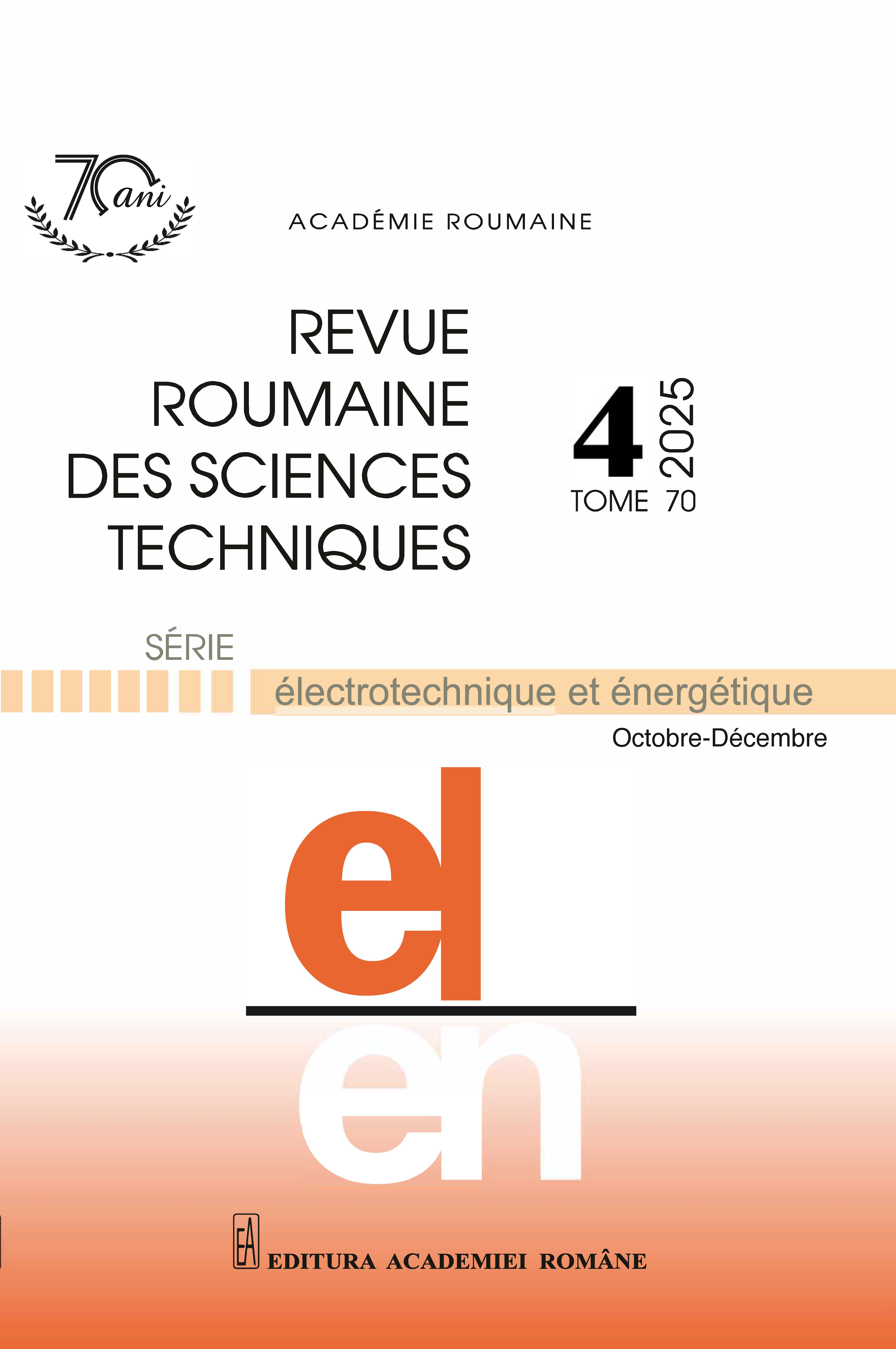POWER QUALITY EVOLUTION FOR WIND ENERGY CONVERSION SYSTEMS USING EMBEDDED Z-SOURCE INVERTER AND PERMANENT MAGNET SYNCHRONOUS GENERATOR
DOI:
https://doi.org/10.59277/RRST-EE.2025.4.5Keywords:
Permanent magnet synchronous generator (PMSG), Embedded Z-source inverter (EZSI), Total harmonics distortion (THD), Fuzzy logic controller (FLC), Z-source inverter (ZSI), Wind energy conversion system (WECS)Abstract
This study focuses on two key goals: maximising wind power and providing the system with high-quality electricity. A permanent-magnet synchronous generator and an embedded Z-source inverter are used in this setup to increase the voltage. The Permanent Magnet Synchronous Generator is employed for its unique features, including excellent performance, low weight and volume, and the fact that it doesn't require an external power source to excite its permanent magnets. The DC-link embedded Z-Source inverter is used to connect this generator to the electrical grid. Typically, the Z-Source connection requires many turns in the transformer winding; however, in this case, lower-rated windings are used for inductance instead of the transformer. Thus, the voltage gain is also balanced by the parallel capacitances. Moreover, symmetrical voltage and current distribution across the network, as well as reduced voltage stresses, are benefits of embedded technology. The recommended method, the embedded Z-Source inverter, is specifically controlled by a fuzzy logic controller that also tracks the maximum power to the wind system and reduces total harmonic distortion by 0.86%, as recorded in MATLAB. However, results were also confirmed from an experimental prototype perspective.
References
(1) M.E. Şahin, Comparison of IG and DFIG for wind power generation systems, Gazi Journal of Engineering Sciences, 6, 3, pp. 230–241 (2020).
(2) N.G. Khani, Improving fault ride-through capability of induction generator-based wind farm using static compensator during asymmetrical faults, Electrical Energy System (2021).
(3) A.P. G and H.S. H, A comprehensive review of fault ride-through capability of wind turbines with grid-connected doubly fed induction generator, Int Trans Electr Energy Syst (2020).
(4) R. Elumalai, Maximum power quality tracking of ANN controller-based DFIG for wind energy conversion system, Rev. Roum. Sci. Techn. – Électrotechn. et Énerg., 69, 2, pp. 189–192 (2024).
(5) G. Shahgholian and S.M. Zanjani, A study of voltage sag in distribution system and evaluation of the effect of wind farm equipped with doubly-fed induction generator, Rev. Roum. Sci. Techn. – Électrotechn. et Énerg., 68, 3, pp. 271–276 (2023).
(6) I. Yaichi and A. Semmah, Control of doubly-fed induction generator using artificial neural network controller, Rev. Roum. Sci. Techn. – Électrotechn. et Énerg., 68, 1, pp. 46–51 (2023).
(7) M. Mohan and K.P. Vittal, Modeling and simulation of PMSG-based wind power generation system, In IEEE Xplore, 3rd IEEE International Conference on Recent Trends in Electronics, Information & Communication Technology (RTEICT) (2018).
(8) P. Chaturvedi and D.K. Palwalia, PMSG-based standalone wind energy conversion system with power quality enhancement, International Journal of Renewable Energy Research-IJRER, 13, 2 (2023).
(9) S. Data, A. Islam, T. Saikia, and S. Adhikari, Performance study of a grid-connected permanent magnet synchronous generator-based wind turbine system, In IEEE Xplore, International Conference on Computer, Communication, Chemical, Materials and Electronic Engineering (IC4ME2) (2020).
(10) A.J. Balbino, B.D.S. Nora, and T.B. Lazzarin, An improved mechanical sensor less maximum power point tracking method for permanent-magnet synchronous generator-based small wind turbine systems, IEEE Trans Ind Electr, 69, 5, pp. 4765–4775 (2021).
(11) S. Piriienko, T. Röser, M. Neuburger, and A. Balakhontsev, Current source gate drivers for 3-phase VSI operated in small-scale wind turbine systems, International Journal of Electrical Power & Energy Systems, 141 (2022).
(12) A.Chakrabarti, P.K. Sadhu, and P. Pal, A novel dead-time elimination strategy for voltage source inverters in induction heating systems through fractional order controllers, Rev. Roum. Sci. Techn. – Électrotechn. et Énerg., 67, 2, pp. 181–185 (2022).
(13) Z. Alnasir and M. Kazerani, Dynamic average modeling of a CSI-based small-scale standalone wind energy conversion system, In IEEE Xplore, 2018 IEEE Electrical Power and Energy Conference (EPEC) (2019).
(14) X. Tan and J. Dai, A novel converter configuration for wind applications using PWM-CSI with diode rectifier and buck converter, Electrical Engineering (2011).
(15) S.A. Kamilu, A. Mohammed, B. Ummai, S. Ikuforiji, A. Michael, and A. Muyideen, Maximum boost PWM control technique of three-phase ZSI-based wind energy conversion systems, International Journal of Scientific Research in Science, Engineering and Technology, 6, 5, pp. 191–201 (2019).
(16) S. Nath, H.C. Nannam, and A. Banerjee, Grey wolf-optimized MPPT controller for q-ZSI-based grid-tied wind power generation system, Electr Eng, 106, pp. 3445–3460 (2024).
(17) M. Abbasi, A.H. Eslahchi, and M. Mardaneh, Two symmetric extended-boost embedded switched-inductor quasi-Z-source inverter with reduced ripple continuous input current, IEEE Transactions on Industrial Electronics, 65, 6, pp. 5096–5104 (2018).
(18) O.B. Heddurshetti, J. Chavan, S. Sanadi, V. Patil, and K. Magadum, Design and implementation of trans-Z-source inverter, International Journal of Emerging Technologies and Innovative Research, 5, 9, pp. 762–766 (2018).
(19) A. Beddar, H. Bouzekri, B. Babes, and H. Afghoul, Real-time implementation of improved fractional order proportional-integral controller for grid-connected wind energy conversion system, Rev. Roum. Sci. Techn. – Électrotechn. et Énerg., 61, 4, pp. 402–407 (2016).
Downloads
Published
Issue
Section
License
Copyright (c) 2025 REVUE ROUMAINE DES SCIENCES TECHNIQUES — SÉRIE ÉLECTROTECHNIQUE ET ÉNERGÉTIQUE

This work is licensed under a Creative Commons Attribution-NonCommercial-NoDerivatives 4.0 International License.


